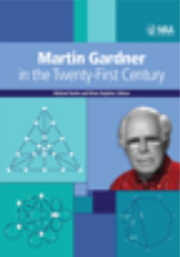Book contents
- Frontmatter
- Preface
- Contents
- I Geometry
- II Number Theory and Graph Theory
- III Flexagons and Catalan Numbers
- IV Making Things Fit
- 17 L-Tromino Tiling of Mutilated Chessboards
- 18 Polyomino Dissections
- 19 Squaring the Plane
- 20 Magic Knight's Tours
- 21 Some New Results on Magic Hexagrams
- 22 Finding All Solutions to the Magic Hexagram
- 23 Triangular Numbers, Gaussian Integers, and KenKen
- V Further Puzzles and Games
- VI Cards and Probability
- VII Other Aspects of Martin Gardner
- Index
- About the Editors
20 - Magic Knight's Tours
from IV - Making Things Fit
- Frontmatter
- Preface
- Contents
- I Geometry
- II Number Theory and Graph Theory
- III Flexagons and Catalan Numbers
- IV Making Things Fit
- 17 L-Tromino Tiling of Mutilated Chessboards
- 18 Polyomino Dissections
- 19 Squaring the Plane
- 20 Magic Knight's Tours
- 21 Some New Results on Magic Hexagrams
- 22 Finding All Solutions to the Magic Hexagram
- 23 Triangular Numbers, Gaussian Integers, and KenKen
- V Further Puzzles and Games
- VI Cards and Probability
- VII Other Aspects of Martin Gardner
- Index
- About the Editors
Summary
In Mathematical Magic Show [4], Martin Gardner looked at the classic problem of the knight's tour on a chess board, paying particular attention to tours in which the numbers in each row and column added to 260. At that time, the question of whether the numbers in each long diagonal could also be made to add to 260 was still open. Thanks to advances in computer power since Martin wrote, this question has now been decided, and perhaps readers will be interested in the complete statement that it is now possible to make.
A brief history of magic knight's tours
In knight's tour literature, the term magic is used for all tours in which the rows and columns add to the same number. Any diagonal or other properties are a bonus. Figure 20.1a is an example. This is a closed tour (the starting and finishing squares are a knight's move apart), and it has two-fold rotational symmetry (numbers which are diametrically opposite differ by 32, so if we draw the lines joining each number to the next, and 64 to 1, we get a pattern which repeats itself on rotation through 180 degrees). No knight's tour on an 8×8 board can be laterally or diagonally symmetric, nor can it have more than two-fold rotational symmetry, so Figure 20.1a has as much symmetry as we can hope for. We may notice that the numbers along a row or column are alternately odd and even.
- Type
- Chapter
- Information
- Martin Gardner in the Twenty-First Century , pp. 153 - 158Publisher: Mathematical Association of AmericaPrint publication year: 2012



